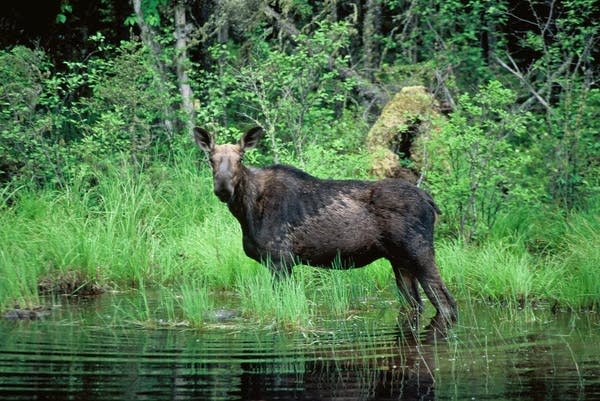Warmer weather threatens moose in Minnesota
Go Deeper.
Create an account or log in to save stories.
Like this?
Thanks for liking this story! We have added it to a list of your favorite stories.

The moose calf didn't seem to want to get out of the water.
But its mother, perhaps concerned about approaching boats, decided it was time to leave. She waded back into the reeds along the Sea Gull River and nudged her light brown offspring. Then she bounded through the thick brush into the forest, her calf struggling to keep up. In moments, both were gone.
Researchers say such sightings of moose, an icon in Minnesota's northwoods, are likely to become more rare. A special advisory committee warned last month that climate change threatens moose in Minnesota and recommended several steps to help them.
Minnesota is one of the few strongholds for moose in the lower 48 states. Among other states with moose, only Alaska and parts of New England and the Rocky Mountains have large, stable populations.
Turn Up Your Support
MPR News helps you turn down the noise and build shared understanding. Turn up your support for this public resource and keep trusted journalism accessible to all.
Maine has the most moose in the lower 48 states, estimated at 60,000 by wildlife officials. Maine, New Hampshire, Vermont and Idaho have stable moose populations, and the animals are spreading in some northwestern states. They're also common in Canada, where there are an estimated 110,000 in Ontario alone, but scientists there express similar concerns as their U.S. counterparts.
Minnesota has an estimated 7,600 moose, nearly all in the forests of northeastern Minnesota, where plentiful swamps, lakes and streams provide good habitat. Yet they're beleaguered by increasingly warm weather and parasites such as brainworms, ticks and liver flukes.
"Almost without exception all of the indicators are that the population is declining," said Mark Lenarz, a moose expert with the Minnesota Department of Natural Resources.
Researchers said they weren't sure why the animal is struggling more in Minnesota than elsewhere and more study is needed.
In August, Minnesota's Moose Advisory Committee called on the state to do more to preserve and develop moose habitat, including ensuring adequate food supplies, providing shade in the summer and reducing parasites.
The committee also recommended managing hunting to hold down the number of deer and limit the spread of parasites from deer to moose. The panel didn't recommend changes in moose hunting rules, which award permits via a lottery and limit hunters to just one moose hunt in their lifetime. The number of moose killed by hunters is too small to affect the population much, the panel said.
Panel chairman Rolf Peterson, a moose researcher from Michigan Technical University, said colder weather during the past two years has been good for northern Minnesota moose but the population hasn't measurably improved.
Mortality rates in radio-collared moose are too high to sustain the population, Peterson said. Research by Minnesota's Department of Natural Resources put the average non-hunting mortality among collared moose at 21 percent since 2002.
"Those moose are not doing well, and they're dying of health-related reasons," Peterson said. "They're exposed to a lot of pathogens, and it's not clear what they're dying from."
Peterson knows something about moose under stress. He's well known for his studies of the uneasy relationship between moose and wolves in Michigan's Isle Royale National Park, a remote archipelago in Lake Superior.
Isle Royale's dense moose population fell to about 530 last winter. That put it as low as it's been in 50 years of study, Peterson said. And the shrinking food source provided by the moose threatens Isle Royale's wolves, which numbered about 24 during the winter survey.
Warmer weather is considered one of the main reasons for the near-disappearance of moose from northwestern Minnesota, where their numbers have plunged from at least 4,000 in the early 1980s to fewer than 100. The advisory committee's report warns that they may never recover to significant numbers.
The habitat is more favorable in northeastern Minnesota, where Grand Marais pilot Dan Anderson takes tourists on moose scouting flights. Anderson, who's been flying in the area for 26 years, said he saw moose on nearly every flight this summer and spotting also was great last fall.
"It looks like the cows are having a pretty good birthrate this year," Anderson said. "I'm seeing many cows with twins."
But Anderson doesn't think his local moose are out of danger, either. For 15 years, he promised customers their flight would be free if they failed to spot a moose. He dropped the guarantee last year after it became too risky.




